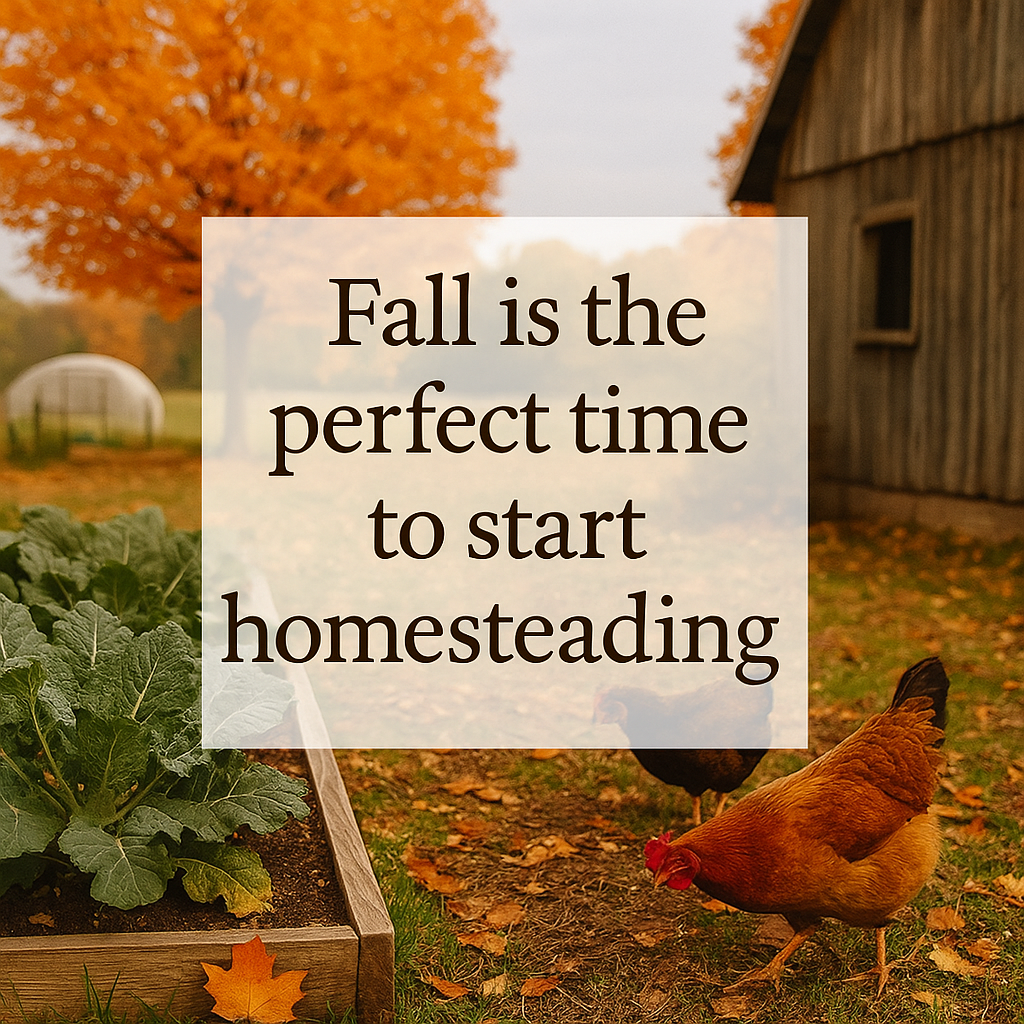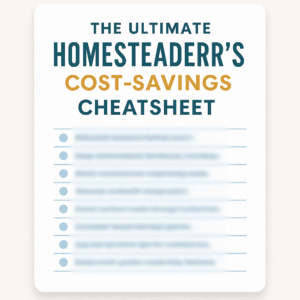Homesteading.
Just the word stirs something in us—images of golden fields, baskets of fresh eggs, rows of vegetables, and the satisfaction of living closer to the land. For many, it feels like a far-off dream that requires acres of farmland, a tractor, and a lifestyle overhaul.
But, here’s the truth: you don’t have to wait, and you don’t have to have it all figured out. You can begin your homesteading journey this autumn—right where you are, with what you have.

Fall is, in many ways, the perfect season to start. The air is crisp, the harvest is everywhere, and the slower pace of the season invites reflection and preparation. So if you’ve been feeling that nudge to finally start your homestead journey, let’s talk about how to do it the smart way.
Step 1: Define Your Homestead Vision
Before you build a coop or plant garlic, take a moment to step back and think about what “homesteading” means to you. For some, it’s about food independence—growing vegetables, preserving them, and raising a flock of chickens. For others, it’s more about lifestyle: slowing down, learning lost skills, and living with intention.
You don’t need to have the entire blueprint figured out. Start with your “why.” Is it healthier food for your family? Saving money? Reducing reliance on the grocery store? Or maybe it’s the simple joy of working with your hands and watching something grow.
Here’s the key: start small. It’s tempting to want to dive in with a full garden, animals, and projects galore. But the best way to succeed is to pick one or two small, doable steps this season. Think:
- Building one raised bed.
- Starting a compost pile.
- Planting garlic or onions.
- Setting up a rain barrel.
Every great homestead started with a single step.
Step 2: Start with Seasonal Planting
Many people think gardening is only for spring, but autumn is a gardener’s secret weapon. Fall crops thrive in cooler temperatures and often taste even better when kissed by frost. Some of the best beginner crops for fall include:
- Kale 🥬
- Spinach
- Carrots 🥕
- Radishes
- Garlic (planted in the fall, harvested next summer)
- Onions
Planting now not only gives you food in the cooler months, but it sets you up for spring success. Garlic planted in October or November quietly establishes itself over winter and comes roaring to life in spring. Leafy greens can be protected with simple row covers to extend the season.
And let’s not forget about the soil. Fall is the best time to feed your soil with compost, leaves, or mulch so it’s rich and ready for spring planting. Building healthy soil now is one of the smartest moves you can make as a new homesteader.
Step 3: Build Your First Homestead Systems
A homestead isn’t just about planting things; it’s about creating systems that work with nature, not against it. Autumn is the perfect time to put some of these systems in place.
Composting:
Grab those falling leaves and kitchen scraps and start a compost pile. You don’t need fancy bins—just a corner of your yard will do. Layer “greens” (like food scraps or grass clippings) with “browns” (like leaves, cardboard, or straw) and let nature do the work. Come spring, you’ll have “black gold” for your garden.
Watering:
Set up a soaker hose or drip irrigation on a simple hose timer. It’s inexpensive, saves time, and ensures your plants are watered consistently. Even if you don’t have crops in the ground yet, you’ll thank yourself in spring when your system is already ready.
Food Storage:
If you have access to local produce, practice preserving it. Try canning apple butter, freezing chopped peppers, or drying herbs. Fall harvests are abundant, and learning storage skills now gives you confidence for when your own garden is producing.
Step 4: Prepare for Animals (Optional Beginner Step)
If you’ve dreamed of fresh eggs, fall is a surprisingly good time to get started with chickens. The weather is cooler, reducing stress, and by the time spring rolls around, you’ll already have an established flock.
Start with a small coop (there are plenty of DIY plans online) and 3–5 hens. Chickens require daily care—food, water, and a safe place to roost—but they’re one of the easiest and most rewarding livestock for beginners.
Not ready for animals yet? That’s okay. Use this season to plan. Research breeds, coop designs, and feed options so when you’re ready, you’ll step in confidently.
Step 5: Plan Ahead for Spring
Think of autumn as your launchpad. You’re setting foundations now that will pay off in a few months. A few smart steps include:
- Sketching out a garden layout for spring.
- Ordering seeds early (popular varieties sell out fast).
- Building raised beds or fencing now, so you’re not scrambling in April.
By planning now, you’ll hit the ground running in spring with less stress and more joy.
Common Mistakes to Avoid
Every new homesteader makes mistakes—but you can avoid the most common ones by starting smart.
- Overcommitting. Don’t try to do it all at once. Pick one or two projects this fall and do them well.
- Forgetting frost protection. Even hardy crops can benefit from row covers or mulch when temps dip.
- Neglecting the big picture. Remember, homesteading is a journey, not a sprint. You’re building skills and systems over time.
Your Homestead Journey Starts Here
The dream of homesteading isn’t something far off—it’s right here, right now. Fall is calling, with its crisp mornings, colorful leaves, and abundance of opportunities to begin.
Start with a single raised bed. Begin composting those leaves. Plant a handful of garlic cloves. Every little action adds up to momentum, and before you know it, you’ll look back and realize you’ve already begun living the homestead life you’ve been dreaming about.
So here’s your invitation: take that first step today. Your future self—and your future homestead—will thank you.
🌻 Follow Smarter Homestead Living for more tips, guides, and inspiration to make your homesteading journey simple, smart, and sustainable.
